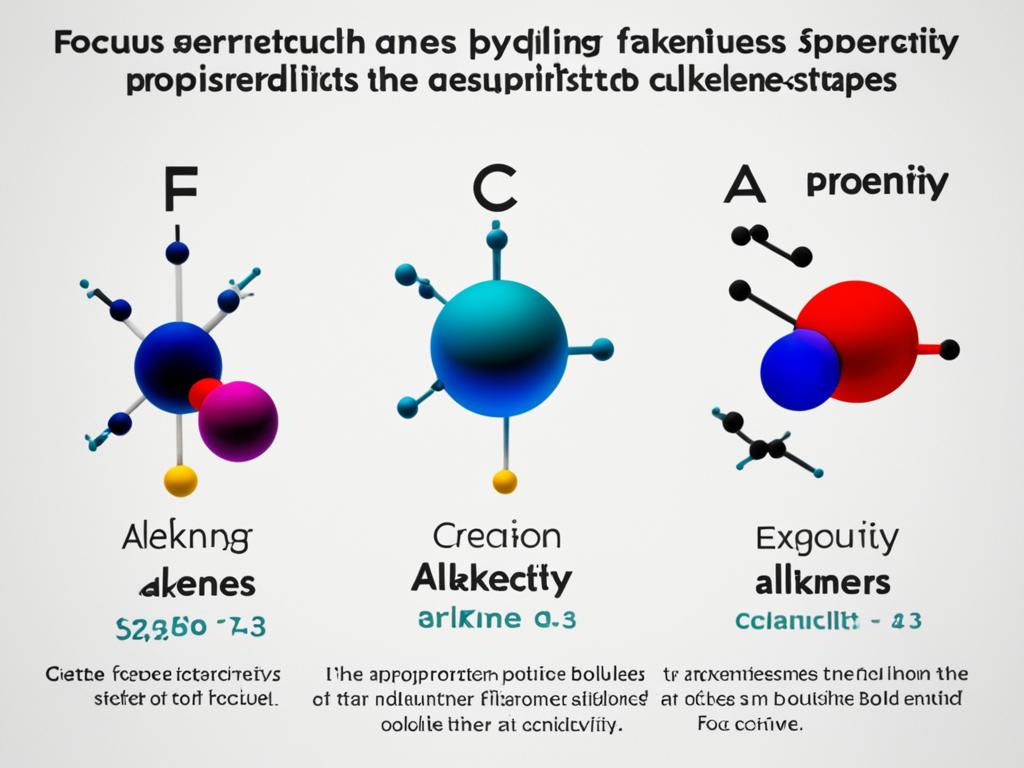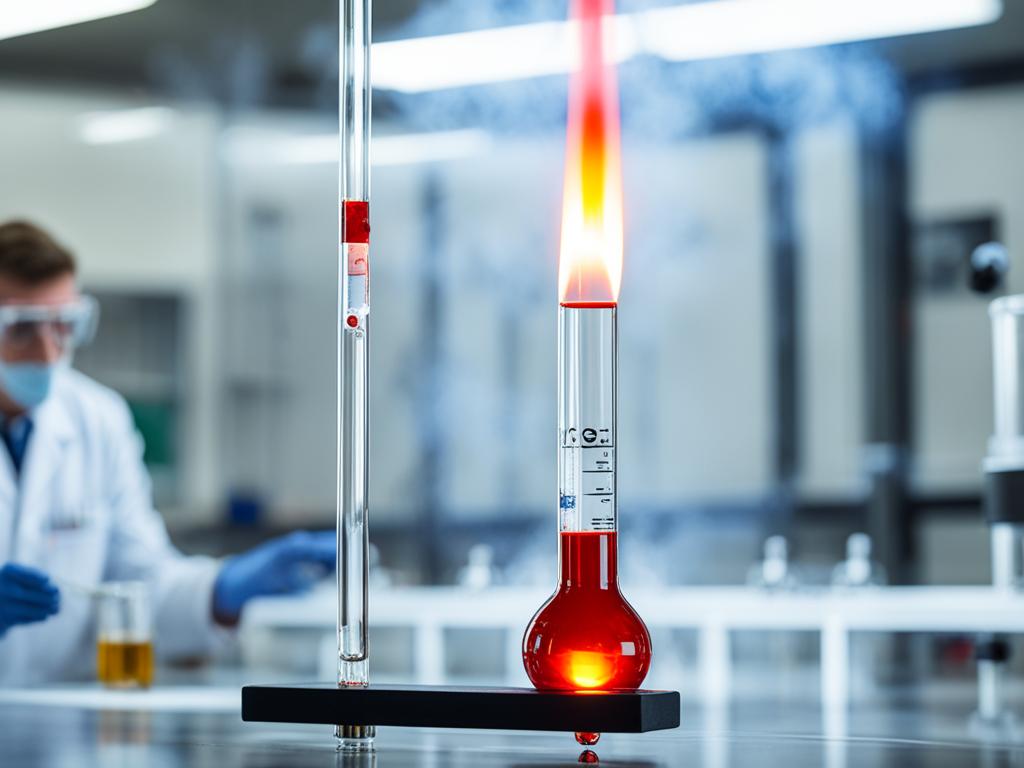There are three classes of hydrocarbons: alkanes, alkenes, and alkynes. They all have carbon and hydrogen atoms only. Each class reacts in its own unique way.
Combustion, substitution, addition, elimination, hydrogenation, halogenation, and carbonyl insertion are some reactions they can go through.
Key Takeaways:
- Alkanes, alkenes, and alkynes are the three main classes of hydrocarbons.
- Alkanes burn and can swap parts through substitution reactions. Alkenes and alkynes can add or take away parts in chemical reactions.
- Other reactions like hydrogenation, adding halogens, and inserting carbonyls are also important for these compounds.
- The chemical industry in the US makes a lot of ethylene. This is used to make polyethylene and other chemicals.
- Alkenes are crucial for making many items we use, like plastics and isopropyl alcohol.
Introduction to Alkanes, Alkenes, and Alkynes
Alkanes, alkenes, and alkynes are the key types of hydrocarbons. They consist of carbon and hydrogen atoms only. Alkanes have only single carbon-carbon bonds, making them saturated. On the other hand, alkenes and alkynes have double and triple carbon-carbon bonds, making them unsaturated.
Definition of Alkanes
Alkanes fall under saturated hydrocarbons. They have just single carbon-carbon bonds. Their general formula is CnH(+/-)n. Here, n stands for the carbon atom number in the molecule.
Definition of Alkenes
Alkenes are unsaturated hydrocarbons. They contain at least one carbon-carbon double bond. Their formula is CnH(+/-)n. Again, n shows the carbon atom count.
Definition of Alkynes
Alkynes are another type of unsaturated hydrocarbons. They have at least one carbon-carbon triple bond. The formula for alkynes is CnH(+/-)n. Like before, n tells us how many carbon atoms are present.
Properties of Alkenes
Physical Properties of Alkenes
Alkenes are unsaturated hydrocarbons with carbon-carbon double bonds. They have physical properties similar to alkanes, their saturated counterparts. As the molar mass of straight-chain alkenes increases, so do their boiling points.
Just like alkanes, alkenes are also insoluble in water. But, they are soluble in organic solvents. This is due to their unsaturated nature.
Chemical Reactivity of Alkenes
Alkenes show distinct chemical reactivity because of the double bond between carbon atoms. This makes them more reactive than alkanes and alkynes. They can undergo different addition reactions.
In these reactions, the pi bond is broken. Then, new sigma bonds form with two new atoms or groups. Examples of these addition reactions include hydrogenation, halogenation, and hydration.
| Physical Property | Alkanes | Alkenes | Alkynes |
|---|---|---|---|
| Boiling Point | Increase with molar mass | Increase with molar mass | Increase with molar mass |
| Solubility in Water | Insoluble | Insoluble | Insoluble |
| Physical State at Room Temperature | Gases | Liquids | Solids |
| Reactivity | Least reactive | More reactive than alkanes | Most reactive |
In conclusion, alkenes have similar physical properties to alkanes. But, they stand out due to their unique chemical reactivity in addition reactions. This sets them apart in the world of unsaturated hydrocarbons.

Reactions of Alkanes
Alkanes, known as the simplest organic compounds, show two main types of reactions. These are combustion reactions and substitution reactions. Because of their stable nature, alkanes don’t easily react. They have strong carbon-carbon single bonds.
Combustion Reactions
When hydrocarbons, like alkanes, burn, they make carbon dioxide and water. If the burn is not perfect, it makes carbon monoxide. With alkanes that have more carbons, the burn might not be total. This is how you get a yellow, smoky flame.
Substitution Reactions
In substitution reactions of alkanes, a hydrogen can be swapped with something else. For example, you can replace it with a halogen. In halogenation, lots of these swaps can happen, not just one. How much of each swapped product you get depends on what you started with.
If you use large alkanes in halogenation, you can get many different products from the swaps. Using bromine to do this is slower than using chlorine.
Reactions of Alkenes
Alkenes, known as unsaturated hydrocarbons, react uniquely. They mainly go through addition to the carbon-carbon double bond. In these addition reactions, the pi bond breaks. Then, new sigma bonds form with two new atoms or groups.
These reactions can be combustion, hydrogenation, halogenation, or hydration.
Addition Reactions
During an addition reaction, the pi bond is broken in alkenes. New sigma bonds are formed. This changes the double bond into a single one. It adds two new groups or atoms across the double bond.
Reactions like hydrogenation, halogenation, and hydration are all part of this process.
Hydrogenation
In hydrogenation, alkenes react with hydrogen gas (H2). They do this with the help of catalysts like platinum or nickel. The reaction turns the alkene into a saturated alkane.
Halogenation
Adding halogens to alkenes is called halogenation. Common halogens used are chlorine (Cl2) or bromine (Br2). This process forms a dihalogenated product by adding halogen atoms to the alkene.
Hydration
Hydration is when water (H2O) is added to alkenes. It turns the double bond into a single one. As per Markovnikov’s rule, the hydrogen from water joins the more substituted carbon.
The result is an alcohol product.
| Reaction Type | Reactants | Products |
|---|---|---|
| Hydrogenation | Alkene + H2 (with catalyst) | Alkane |
| Halogenation | Alkene + Halogen (Cl2, Br2) | Dihalogenated product |
| Hydration | Alkene + H2O (with acid catalyst) | Alcohol (following Markovnikov’s rule) |
Elimination Reactions of Alkenes
Alkenes are unsaturated hydrocarbons that don’t just do addition reactions. They also undergo elimination reactions. Here, small parts are taken out, making carbon-carbon double bonds.
The key elimination reactions are dehydrohalogenation and dehydration. These remove HX from alkyl halides or water from alcohols. They happen through E1 or E2 ways, like how substitution reactions work.
The E2 way is quick, happening in a single step with a bimolecular state. How fast it goes depends on the amount of reactants. On the other hand, E1 is slower and has two steps, making a carbocation intermediate. Both ways have their own rules on how they form carbon-carbon double bonds.
Besides E1 and E2, there are more types of elimination reactions important in the industry. Sometimes E1 and E2 compete or work with other types of reactions. This mix is common in the industry.
Alkenes are key in the petroleum industry and in nature. They are important for making various natural products. These products are the start of many plastics we use daily.
Alkenes react easily because of their extra π-bonding electrons. This makes them attractive to come into reactions with certain molecules. In some cases, they can form two different alkenes in a reaction.
Reactions of Alkynes
Addition Reactions of Alkynes
Just like alkenes, alkynes are also unsaturated hydrocarbons with carbon-carbon triple bonds. The key feature of these addition reactions is that the triple bond breaks. Then, new sigma bonds form with two new atoms or groups. Although they react less with certain molecules than alkenes, alkynes still join in many organic chemistry reactions.
When alkynes take part in addition reactions, they often form geometric isomers. This happens because the three bonds in the triple bond can break one by one. Thus, different products can be made. These reactions are vital in making complex organic compounds. They are also used to create chemicals in the pharmaceutical and fine chemical fields.
| Reaction | Product(s) |
|---|---|
| Hydrogenation | Alkanes |
| Halogenation | Dihalogenated or tetrahalogenated products |
| Hydration | Carbonyl compounds via enol intermediates |
| Oxidation | Carboxylic acids |
| Partial Reduction | Alkenes |
Alkynes are very useful in making complex organic molecules. They are key in producing pharmaceuticals, agrochemicals, and other fine chemicals. Their role in addition reactions is essential for these processes.

Reactions of Alkanes
Alkanes are limited in the number of reactions they can have compared to alkenes and alkynes. The key reactions they undergo are combustion and halogenation.
In combustion, alkanes react with oxygen fully, producing carbon dioxide and water. This reaction is very important for calculating energy. Yet, burning larger alkanes can be hard because they are less volatile. This might cause incomplete combustion, forming carbon or carbon monoxide. Larger alkanes can show a yellow, smoky flame when they don’t burn completely.
Halogenation is the process of swapping atoms of hydrogen in alkanes with halogen ones like fluorine or chlorine. It results in different products based on the specific reactants. For example, UV light on methane can give chloromethane, dichloromethane, trichloromethane, and tetrachloromethane. Doing this with bigger alkanes gives a variety of replacement products.
Source Links
- https://wou.edu/chemistry/courses/online-chemistry-textbooks/ch105-consumer-chemistry/ch105-chapter-8/
- https://pa01000125.schoolwires.net/cms/lib/PA01000125/Centricity/Domain/366/Chap5 Alkene Rxns.pdf
- https://chem.libretexts.org/Bookshelves/Organic_Chemistry/Basic_Principles_of_Organic_Chemistry_(Roberts_and_Caserio)/10:_Alkenes_and_Alkynes_I_-_Ionic_and_Radical_Addition_Reactions
- https://unacademy.com/content/nda/study-material/chemistry/alkanes-alkenes-and-alkynes/
- https://uen.pressbooks.pub/introductorychemistry/chapter/alkenes-and-alkynes/
- https://chem.libretexts.org/Courses/Heartland_Community_College/HCC:_Chem_162/22:_An_Introduction_to_Organic_Chemistry/22.2:_Alkanes,_Cycloalkanes,_Alkenes,_Alkynes,_and_Aromatics
- https://chem.libretexts.org/Bookshelves/General_Chemistry/Map:_General_Chemistry_(Petrucci_et_al.)/27:_Reactions_of_Organic_Compounds/27.07:_Reactions_of_Alkanes
- https://people.chem.ucsb.edu/neuman/robert/orgchembyneuman.book/09 EliminationReactions/09Separates/09Text.pdf
- https://chem.libretexts.org/Bookshelves/Organic_Chemistry/Organic_Chemistry_I_(Morsch_et_al.)/08:_Alkenes-_Reactions_and_Synthesis/8.01:_Preparation_of_Alkenes_-_A_Preview_of_Elimination_Reactions
- https://www.masterorganicchemistry.com/2014/01/29/synthesis-5-reactions-of-alkynes/
- https://www.vaia.com/en-us/textbooks/chemistry/chemistry-13-edition/chapter-24/problem-8-describe-reactions-that-are-characteristic-of-alka/


